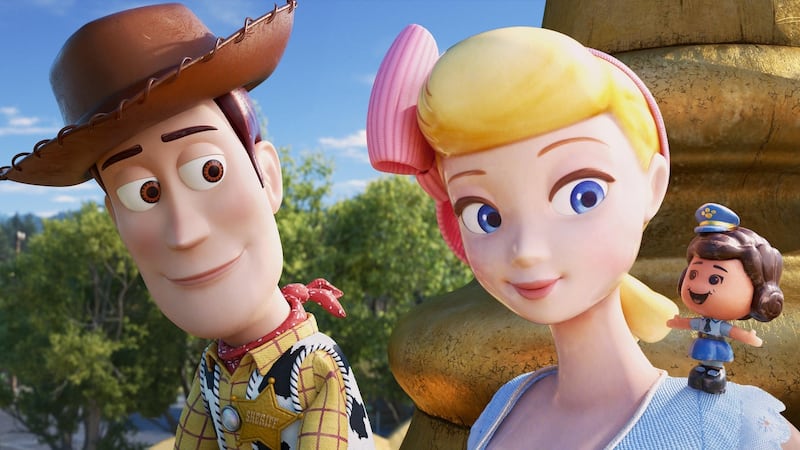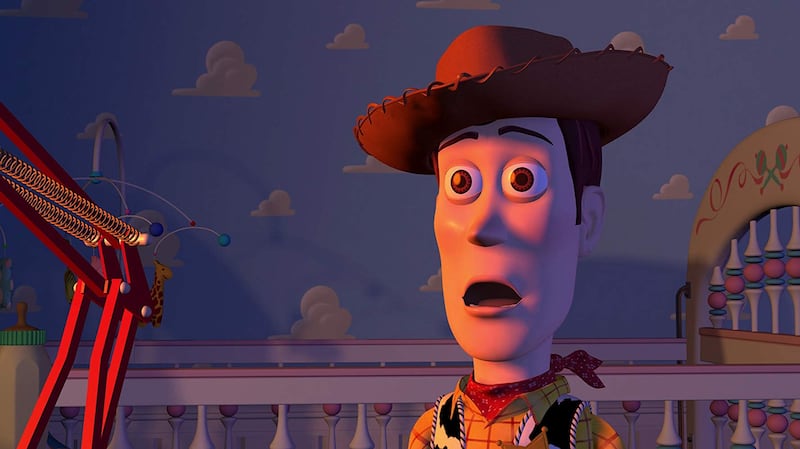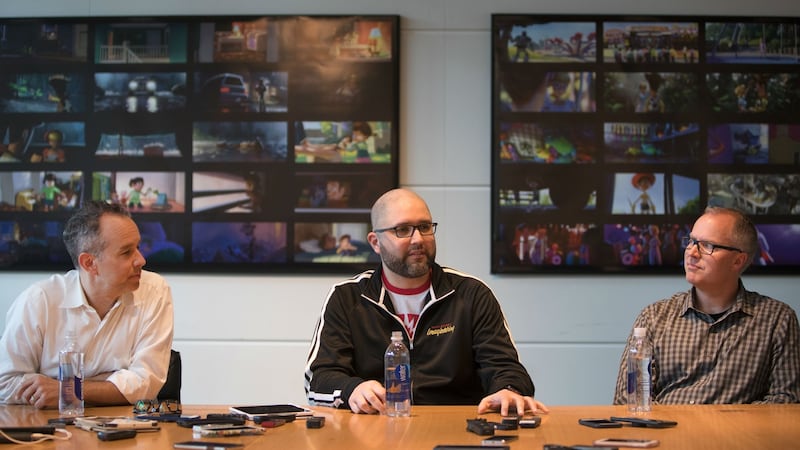There's a moment in Toy Story 4 in which Bonnie (the little girl who inherited the franchise's central characters at the end of Toy Story 3) and her parents are pictured outside the family RV. Mom is doing a little light holiday reading: Beyond Infinity: Debunking the Theory of a Shared Universe. The book is a nod to the popular online hypothesis which holds that all of the Pixar films take place in the same universe. (Thus, Meredith's discovery of will-o'-the-wisps in Brave would bring the magic into the world that would ultimately gift The Incredibles their superpowers. And so on.)
"We like to say that the fan theories make us come off a lot smarter than they actually are," says Toy Story 4 producer Jonas Rivera. "But I love hearing them."
The book may use the word “debunking” but Toy Story 4 has plenty of details in the margins that support the idea of a shared Pixar universe.
"I don't even know how many Easter eggs there are in the film," says Toy Story 4 director Josh Cooley. "There's a lot. I haven't found them all either. I'm going to have to go through it and keep pausing. Bing Bong's wagon and the scream canisters from Monsters Inc are in there.
“I have a 10-page document that shows which Easter eggs are there from different films. Because our film has an antique store, the set dressers had to fill it with 10,000 items and make all those things look like they had been there for years and years. So they would say: let’s use the house from Up and shrink it down and put it in the back as a dollhouse.”
It’s not merely a connected universe. Almost a quarter of a century has passed since Pixar’s Toy Story opened to rave reviews and $356 million (€317 million) in box office returns. That has proved plenty of time for the franchise’s most passionate fans to mull over the trilogy and extrapolate all kinds of everything.
Many fan ideas are inspired by simple textual analysis, including the notion that Wheezy is the villain of Toy Story 2 and that Andy’s mom is Cowgirl Jessie’s original owner, as the girl who had the cowgirl toy many years ago has an identical hat as Andy, which he may, in turn, have inherited from his mom.
I haven't got around to the Illuminati theory of Toy Story
Other eagle-eyed viewers, noting the apparel, have decided that the garbage man in Toy Story 3 is Sid, who, haunted by learning that toys are conscious in the original Toy Story, has devoted his life to rescuing toys from the trash.
“Well, the garbage man in Toy Story 3 is definitely Sid,” says Josh Cooley. “He’s wearing the same skull T-shirt and the director, Lee Unkrich, has confirmed that it’s him. But I haven’t got around to the Illuminati theory of Toy Story.”

Yes, there's an Illuminati theory. It pertains specifically to Toy Story 3 and was inspired by that film's Federal Emergency Management Agency suitable watchtowers, Mrs Potatohead's eye, and Barbie paramour Ken's analysis of power: "He's made us into a pyramid," he says of the film's villain, Lotso: "and he put himself on top!"
My favourite theory is that Toy Story is the echo of The Walking Dead
The same film has been read as a restaging of the Communist Revolution by MC Huntington and as an echo of the Holocaust by Jordan Hoffman. Hoffman has also claimed that Barbie is a mouthpiece for Marxist martyr Rosa Luxemburg, noting her rallying cry: "Authority should derive from the consent of the governed, not from threat of force."
Other lower-brow interpretations suggest that Toy Story is a continuation of the original TV series of Roseanne after Dan dies (proponents point to the absence of a father in Toy Story and the voice work of Roseanne star Laurie Metcalf).
“My favourite theory is that Toy Story is the echo of The Walking Dead,” says Rivera. “I love that one. It’s one of those theories you think is ridiculous and you look at it and think: oh, that’s a pretty good point, actually. I’m a big fan of The Walking Dead so that’s my favourite weird, zeitgeist connective tissue thing.”

These odd ideas are no odder than the franchise they cling to. For any number of reasons, the film that was almost called Made in Taiwan – other rejected titles included Toyz in the Hood and The New Toy – should not have worked. The 1995 movie was a joint venture between Disney and Pixar, a start-up – then chaired by Steve Jobs – that had been given a $26 million deal for three computer-animated, feature-length movies.
Until that time, neither Pixar nor anyone else had managed such a feat. There were technical issues with any shape more sophisticated than block so a writing team that included director John Lasseter, Andrew Stanton and Joss Whedon chose to focus on storytelling. They poured over Aristotle's Poetics and, in a related move, attended a weekend conference with screenwriting magus Robert McKee. Lasseter screened Hayao Miyazaki's Castle in the Sky for further inspiration.
Steve Jobs had to cover the rent until Woody was revised
Having studied films that had lasted despite dated special effects, notably The Wizard of Oz and Star Wars, the Toy Story team turned in a script for a snarky Midnight Run-style buddy movie featuring a jaded ventriloquist cowboy puppet named Woody.
Disney was horrified. Steve Jobs had to cover the rent until Woody was revised from jerk to, as Jonah Rivera puts it: "a guy who is really worried about losing his job".

Buzz, too, was greatly altered from his original design. The character was initially based on the old-fashioned metallic plaything at the centre of Pixar’s 1988 Oscar-winning short, Tin Story. Tinny, as he was known, then morphed into an Action Man figure and then, finally, into a spaceman, first called Lunar Larry, then Tempus from Morph, then Buzz in tribute to the astronaut Buzz Aldrin.
Equally welcome revisions included the transformation of Mexican temptress Señorita Cactus into level-headed Bo Peep.
There were further stumbling blocks and happy accidents when Billy Crystal turned down the role of Buzz Lightyear to make way for Tim Allen. Joss Whedon originally wanted Barbie for a role closely related to his most famous creation, Buffy the Vampire Slayer. Mattel, however, refused to license the doll to Pixar. (They relented by the sequel, which features Tour Guide Barbie.) The team also wanted GI Joe but had to make do with the generic invention, Combat Carl. It was touch and go with Mr Potatohead's licensing lawyer, but Pixar won that particular battle.
Global hit
Once all the stars aligned, Toy Story was a global hit, propelling Steve Jobs towards his first billion and hysterical parents toward the emptied shelves of toy stores, as the small Canadian-based manufacturer Thinkway Toys – Hasbro and Mattel had both turned down the toy licence for the Toy Story franchise – struggled to meet demand.
The film that is written up in the Guinness Book as Records as the first CG feature was simply unlike anything else.
“I first saw Toy Story with my brother in a local cinema,” says Josh Cooley, who was 15 when the original film was released. “I knew I was watching something I had never seen before, something that was groundbreaking.
“Obviously it’s the first CG film. But just story wise, it wasn’t musical, it didn’t have any princesses, it didn’t have a villain, which was totally different from anything I had seen at the time.”

Surprisingly, Toy Story 2 was yet another struggle for the fledgling company. Having scored more than $100 million in sales for the straight-to-video Aladdin sequel, The Return of Jafar, Disney was keen that Toy Story 2 bypass the theatrical circuit. After much negotiation and a little padding, Toy Story 2 was released in cinemas in 1999, taking home $497.4 million. The concluding instalment of the Toy Story trilogy, released in 2010, more than doubled that, with a $1.067 billion take. And that should have been that. Even the makers of Toy Story 4 admit to a degree of anxiety in the unexpected resurrection of the franchise.
“We had animators working on the film who saw Toy Story when they were four,” says Jonas Rivera, who joined Pixar as an intern during the production of Toy Story.
“It was the first film they saw in a cinema. Those younger people who were working on the crew actually taught us that we were aiming too low, to be honest. We would say things like: we have to make sure it’s as good as Toy Story 3 or that it can’t mess up the other Toy Story films. But they would say: no, you have to make sure you don’t wreck my childhood.”
Plot
Toy Story 4 sees Woody struggling to find purpose in Bonnie’s room and wrestling with a wayward new toy named Forky, a kindergarten creation of Bonnie’s. A family holiday reintroduces Bo Peep, now a survivalist lost lamp, and brings on new characters including Canadian motorcycle daredevil Duke Caboom (voiced by Keanu Reeves), creepy antique doll Gabby Gabby (Christina Hendricks) and cuddly carnival prizes-in-waiting Ducky and Bunny (Keegan-Michael Key and Jordan Peele).
“It was an idea Andrew Stanton was cooking up during Toy Story 3,” says Toy Story 4 producer Mark Nielsen. “But he kept it to himself for a little while. He had a handshake agreement with the creative leadership of the studio that they wouldn’t put forward an idea for Toy Story 4 unless they had an idea that all of them felt was worthy of being told.”
The fourth instalment does seem to wave goodbye to the quadrilogy’s main character, but the filmmakers are wary of saying that this is the end for Pixar’s most loved franchise.
“It’s the end for this story,” says Jonas Rivera, diplomatically. His producing partner Mark Nielsen, meanwhile, is currently working on a spin-off series featuring Forky, due to go live with Disney Plus in November.
“It’s really fun,” says Nielsen. “It’s Forky, just three days old, back in the playroom asking questions like: what is love.”
Anyone up for a Toy Story Quintology?
Toy Story 4 is released June 21st











